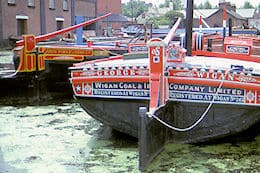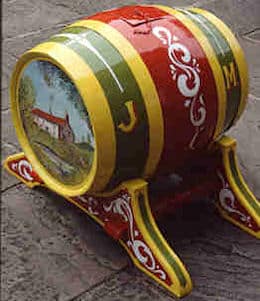Leeds and Liverpool short boats
The cargo boats that developed on the cross-country canal from Leeds to Liverpool are in an interesting category of their own. The canal was started in 1770 and opened in stages (although it was not properly completed for over 40 years,) but it was built to an unusual gauge, considering the areas it linked together.
The locks were only built large enough to accommodate the Yorkshire ‘Keels’ of the Aire, Calder and Humber rivers, about 60 foot long, and were thus too short for the average size Mersey ‘Flat’ from the Liverpool side, or any Midland narrow boat. It is a long navigation and climbs steeply into the hillsides of Lancashire and as water supply to the summit was always going to be difficult, it was built for vessels drawing no more than four feet.
The canal barges that evolved from all these constraints were the Leeds and Liverpool ‘short boats’, about sixty feet long and fourteen feet wide combining styles of construction from both east and west of the Pennines. Most short boats were carvel built wooden craft, fat but efficient with a fine graceful run aft bringing the water smoothly up to a big wooden rudder. Some were ’round sterned’ with all the planks pulled in and fixed to one vertical sternpost and this was the construction favoured by the later motorised short boats as well, with the wooden rudder replaced by a smaller steel one. However, many of the horse boats, especially on the Yorkshire side, were built with a large square transom stern. They did not swim quite as well, but they could carry more cargo and afforded a slightly bigger living cabin below the deck. Unfortunately, there is only a single example of these once common workhorses in existence, and even that is not on its home water for the George is now preserved at the National Waterways Museum at Ellesmere Port in Cheshire.
Steel short boats were being built into the 1950’s and many of these still survive, although scattered around the system. One is even near London after a coastal passage, but several are usually to be seen in or near Manchester, where the Leeds and Liverpool canal proper is joined to the Bridgewater Canal by the Leigh Branch. One restored example is the Bacup that can be visited at Ellesmere Port, and the Kennet is in full heritage operation on the Leeds and Liverpool proper. She is a ‘river’ class short boat built in 1947 and is owned and operated by the Leeds and Liverpool Canal Society as a complete historic community resource.
Leeds & Liverpool ‘Long Boats’.
The westernmost section of the canal from Liverpool to Wigan and the link south to Manchester was built with long enough locks to take the bigger regional barges, the Mersey flats, and this allowed the development of yet another category of craft, the Leeds and Liverpool ‘long’ boats.
They were open boats without covers, similar in construction to the wooden short boats but their extra length gave them extra capacity. They were mainly employed in the coal trade, from the Wigan and Leigh coal mines into Liverpool and Manchester, and along the Bridgewater canal to Runcorn. Only one now survives, the Scorpio at the National Waterways Museum.
Leeds & Liverpool ‘Brightwork’
Leeds & Liverpool canal boats also developed an elaborate and unusual style of decorative paintwork, quite distinct from that of other canal craft. Known to the regional tradesmen as ‘brightwork’ it featured panels of strong colour with contrasting borders carrying intricate painted scrollwork and deeply shaded lettering. Even the guard irons at bow and stern were painted with repeat patterns of stripes, triangles and little fleur-de-lis. Pictures appeared as well but not as constrained in subject matter as the ‘castle’ convention of the narrow boats. Cottages, sailing ships, vases of flowers, horses, windmills – anything and everything that appealed to popular taste could be incorporated within the strong visual framework of the painted panelling, with each corner filled in as a quadrant.
Most of all however, it was the insistent painted scrollwork that gave the short boats their special regional character, a tradition that was in grave danger of being entirely lost. Happily there’s a book on the subject which has done much to record and celebrate this extraordinary localised folk art for the future. See our Off the Mainline article about ‘Brightwork’ and you can order the book ‘Brightwork’ by Mike Clarke from this page.
All materials and images © Canal Junction Ltd. Dalton House, 35 Chester St, Wrexham LL13 8AH. No unauthorised reproduction.
About | Terms | Privacy| Refunds & Returns| Sitemap | Contact Us
With over 800 pages, this website uses cookies to record visitor behaviour using Google Analytics. More information on Privacy Page. Page last updated: 04/01/2025.




Back to Menu....
Narrowboats & Barges >>
Canal Heritage >>